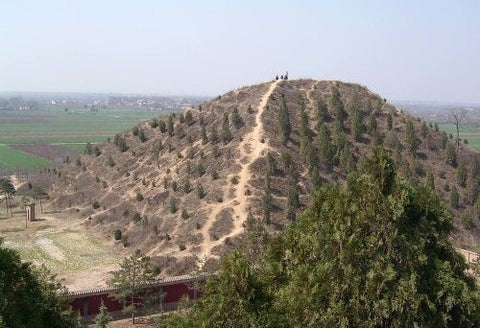The Chinese Pyramids

When we think of ancient pyramids, our minds immediately go to Egypt and the famous Pyramids of Giza . However, did you know that there are also ancient pyramids in China ? These pyramids, although not as well known as their Egyptian counterparts, are just as impressive and have their own history and mystery.
So what are these Chinese pyramids?
China is home to a series of pyramids, often dwarfed by the grandeur of the Great Wall and the Forbidden City . These lesser-known pyramids, scattered throughout the country, are shrouded in mystery and, in many cases, myth. The most famous of these are the pyramids of Shan Xi Province , also known as the "Chinese pyramids".

The pyramid complex of Shaanxi:
Located near the city of Xi'an , the Shan Xi Pyramids are a collection of more than 38 small pyramid mounds. Unlike their Egyptian counterparts, these structures are not monumental in size, but they capture the imagination because of their number and the questions they raise about their origin and function.
Architectural puzzle:
The Chinese pyramids challenge the conventional view of pyramid construction. They are notably devoid of the external formwork stones which characterize the Egyptian pyramids. Instead, they are made of earth and clay. This structural difference has sparked debate among archaeologists and historians about whether these mounds should be considered true pyramids. Some claim they served as burial mounds for emperors, while others suggest astronomical connections.
The Emperor's Tomb:
One of the most discussed pyramids in China is the Mausoleum of Mao Ling , traditionally associated with Emperor Wu of the Han dynasty. This tomb, which is not a true pyramid, resembles the shape of a pyramid and is considered the resting place of the emperor. The interior is believed to consist of a complex array of chambers and passageways, but the mausoleum remains largely unexplored for preservation reasons.
Alignment with the stars:
One of the most intriguing aspects of the Chinese pyramids is their potential alignment with celestial bodies. Some researchers believe that the location of these structures corresponds to certain constellations or has astronomical significance. This fueled speculation about the advanced knowledge of ancient Chinese civilizations in the fields of astronomy and mathematics.
Cultural and historical context:
To understand the Chinese pyramids, one must delve into the rich tapestry of Chinese history and mythology. The Han and Qin dynasties, often associated with these structures, played an essential role in the formation of Chinese civilization. Exploring the cultural and historical context is essential to unlocking the mysteries encoded in these ancient mounds.
Preserve the enigma:
Although efforts have been made to study and preserve these structures, challenges persist. Urbanization and modern development threaten these archaeological sites, highlighting the importance of ongoing research and conservation efforts to safeguard the remains of China's ancient past.
Conclusion :
China's pyramids stand like silent sentinels, guarding the secrets of a bygone era. Their enigmatic nature invites speculation, curiosity and a thirst for understanding. As archaeologists continue to unearth clues and researchers delve deeper into the mysteries of these structures, we get closer to unlocking the secrets that lie beneath China's soil.
A journey that not only sheds light on the ancient past, but changes our understanding of human history and ingenuity. China's often overlooked pyramids are portals to a distant time, waiting to share their stories with those willing to listen.
